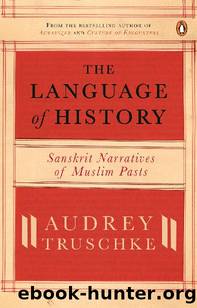The Language Of History by Audrey Truschke

Author:Audrey Truschke [Truschke, Audrey]
Language: eng
Format: epub
Publisher: Penguin Random House India Private Limited
Published: 2021-01-18T00:00:00+00:00
The Maratha-sponsored Sanskrit histories largely concentrate on true events, with a strong political focus. For instance, in his five-chapter ParnÌlaparvatagrahanÌkhyÌna, Jayarama narrates numerous military actions undertaken by Shivajiâs forces against Bijapur and the Mughals, chief among them the seizure of Panhal Fort, a Bijapuri stronghold, in March 1673.89 Keshavaâs RÄjÄrÄmacarita focuses on Rajaramâs 1689 flight to Jinji Fort as he was pursued by Mughal troops, with a positive spin on how Rajaram âwarded off the Lord of Delhiâs prideâ (I guess by various skirmishes en route).90 Keshava wrote within a few months of these events, in January of 1690, and hypes his work, also five chapters, as a âprabandha of fameâ (yaÅaḥprabandhaá¹).91 Even in the expansive SÅ«ryavaá¹Åa, a work of thousands of verses that remains unfinished at thirty-two chapters (the final one incomplete), Paramananda maintains a relentless emphasis on political moments. In the text, the poet narrates the exploits of Shahji and Shivaji to a group of Benares Brahmins, a community who had come to wield intellectual and political influence across much of India in the sixteenth and seventeenth centuries.92 In the SÅ«ryavaá¹Åa, the Benares Brahmins serve, among other functions, to keep Paramanandaâs attention on political developments. For instance, Paramananda segues into speaking of Shivajiâs childhood play (bÄlalÄ«lÄ) at the end of Chapter 7, and then Chapter 8 opens with the pandits asking how Shahji captured Shivneri Fort.93 Chapter 9 concludes with some nice verses on Shivaji learning his first letters, and Chapter 10 begins with the pandits requesting more information on how twelve-year-old Shivaji reached Pune on Shahjiâs orders.94 By my count, the Benares pandits speak around two dozen times in the SÅ«ryavaá¹Åa, and they invariably ask about politics, sometimes snapping the poet out of digressions on other subjects.
Like earlier Sanskrit historians, the Maratha-sponsored historians also wrote their histories through and as poetry, drawing liberally on Sanskrit literary conventions and echoing early works. For instance, the RÄjÄrÄmacarita opens with a conversation between Shiva and Narada.95 The ParamÄnandakÄvya contains a fairly elaborate story about Kali, the current age, taking birth as Shivajiâs wife, Soyarabai, to lead the king astray.96 The ÅambhurÄjacarita, which survives in fragments, has been described as notably heavy on poetry.97 The SÅ«ryavaá¹Åa imitates Kalidasaâs Raghuvaá¹Åa, in both its title and in specific verses.98 The SÅ«ryavaá¹Åa also bills itself in colophons to each chapter as an anupurÄá¹a, a ânew puranaâ.99 âAnupuranaâ is an anomalous genre in the collection of texts I discuss in this book, and it likely was meant to highlight Shivajiâs claim to be part of the solar lineage, one of the five appropriate topics (pañcalaká¹£aá¹a) of a purana.100 Additionally, the SÅ«ryavaá¹Åa cites verses from the Mahabharata and adopts the epicâs meta-framework of a story being told to Brahmins.101 Notably, as described above, Paramananda deployed even the trope of a Brahmin audience in pursuit of, not in spite of, Maratha political history.
Bhonsle Definitions of the Other
The Maratha-sponsored Sanskrit histories often invoke a framework of opposition, Us versus Them, with the identities of both sides defined in military and political terms.
Download
This site does not store any files on its server. We only index and link to content provided by other sites. Please contact the content providers to delete copyright contents if any and email us, we'll remove relevant links or contents immediately.
| Africa | Americas |
| Arctic & Antarctica | Asia |
| Australia & Oceania | Europe |
| Middle East | Russia |
| United States | World |
| Ancient Civilizations | Military |
| Historical Study & Educational Resources |
The Dawn of Everything by David Graeber & David Wengrow(1647)
The Bomber Mafia by Malcolm Gladwell(1583)
Facing the Mountain by Daniel James Brown(1503)
Submerged Prehistory by Benjamin Jonathan; & Clive Bonsall & Catriona Pickard & Anders Fischer(1419)
Wandering in Strange Lands by Morgan Jerkins(1372)
Tip Top by Bill James(1350)
Driving While Brown: Sheriff Joe Arpaio Versus the Latino Resistance by Terry Greene Sterling & Jude Joffe-Block(1338)
Evil Geniuses: The Unmaking of America: A Recent History by Kurt Andersen(1316)
Red Roulette : An Insider's Story of Wealth, Power, Corruption, and Vengeance in Today's China (9781982156176) by Shum Desmond(1314)
The Way of Fire and Ice: The Living Tradition of Norse Paganism by Ryan Smith(1304)
American Kompromat by Craig Unger(1269)
It Was All a Lie by Stuart Stevens;(1263)
F*cking History by The Captain(1254)
American Dreams by Unknown(1234)
Evil Geniuses by Kurt Andersen(1223)
Treasure Islands: Tax Havens and the Men who Stole the World by Nicholas Shaxson(1219)
White House Inc. by Dan Alexander(1177)
The First Conspiracy by Brad Meltzer & Josh Mensch(1139)
The Fifteen Biggest Lies about the Economy: And Everything Else the Right Doesn't Want You to Know about Taxes, Jobs, and Corporate America by Joshua Holland(1090)
